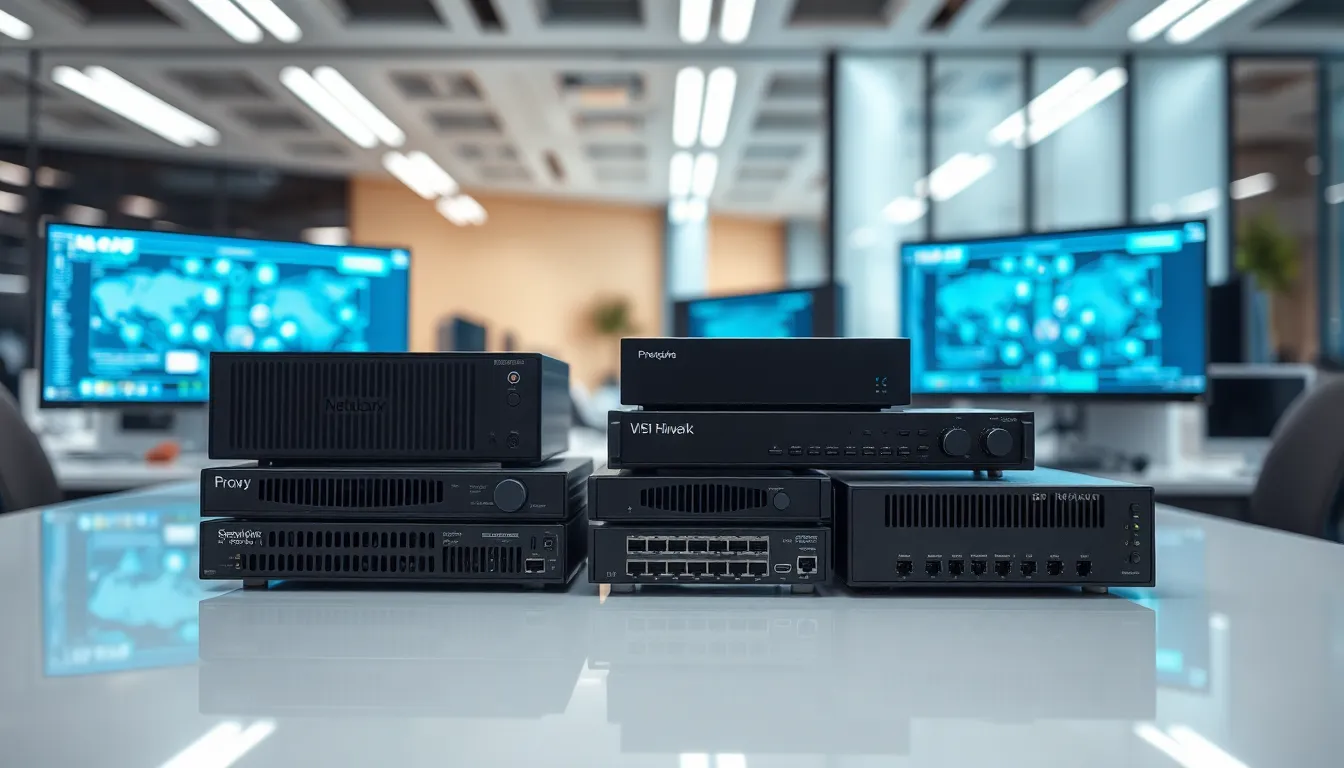In a world where cyber threats lurk around every digital corner, firewalls stand as the unsung heroes of online security. Think of them as the bouncers at an exclusive club, armed with a clipboard and a discerning eye, ready to keep unwanted guests at bay. They’re not just there to look tough; they’re essential for protecting sensitive data from cybercriminals who’d love nothing more than to crash the party.
But firewalls aren’t just about keeping the bad guys out; they also help ensure that your network runs smoothly. Imagine trying to enjoy a quiet evening at home while a herd of wild raccoons rummages through your trash. That’s what it feels like when your network is unprotected! Embracing firewalls isn’t just wise; it’s downright necessary in today’s tech-savvy world. So, let’s dive into the fascinating world of firewalls and discover how they keep your digital life safe and sound.
Table of Contents
ToggleOverview of Firewalls
Firewalls play a vital role in protecting networks from unauthorized access. They act as barriers between trusted internal networks and untrusted external networks. By monitoring incoming and outgoing traffic, firewalls determine whether to allow or block specific data packets based on predefined security rules.
Different types of firewalls exist to address various security needs. Packet-filtering firewalls inspect packets and accept or reject them based on source and destination IP addresses and port numbers. Stateful inspection firewalls maintain records of active connections, providing a more comprehensive analysis of traffic flow. Application-layer firewalls focus on individual applications, filtering traffic at a higher level to enhance security.
Firewalls serve both hardware and software functions. Hardware firewalls are standalone devices protecting the entire network perimeter. Software firewalls, installed on individual devices, offer tailored security measures for personal computers and servers. Each type provides essential protection, enhancing overall cybersecurity posture.
The benefits of firewalls extend beyond intrusion prevention. They help prevent malware infections, ensuring that harmful software doesn’t infiltrate systems. Moreover, firewalls enforce company policies by controlling access to specific websites and applications. These actions significantly contribute to data loss prevention and risk management strategies.
In a rapidly evolving digital landscape, the importance of firewalls continues to grow. As cyber threats become increasingly sophisticated, maintaining a strong firewall defense becomes essential. Organizations leverage firewalls to safeguard sensitive information, ensuring compliance with regulations and protecting their reputation in the industry.
Types of Firewalls

Various types of firewalls serve distinct security functions in network protection. Understanding each type aids in selecting the right firewall for specific needs.
Packet-Filtering Firewalls
Packet-filtering firewalls analyze data packets against predetermined criteria. These criteria often include source and destination IP addresses, port numbers, and protocols. By checking this information, these firewalls either allow or block packets based on security policies. Benefits include low resource consumption and speed, making them suitable for basic security needs. However, they lack advanced features like threat detection or stateful analysis.
Stateful Inspection Firewalls
Stateful inspection firewalls track active connections and maintain a state table to monitor them. Unlike packet-filtering firewalls, they analyze the entire context of traffic, enhancing security capabilities. A state table ensures that only packets matching an established connection can pass through. This type of firewall offers more robust protection by detecting unusual traffic patterns and preventing unauthorized access. High efficiency makes them popular for both personal and organizational use.
Proxy Firewalls
Proxy firewalls act as intermediaries between users and the internet. They intercept requests from clients and forward them to the appropriate server, providing an additional layer of security. These firewalls hide the client’s IP address while filtering requests based on security policies. Proxy firewalls also cache responses, which can improve response times for frequently accessed resources. Organizations often use them for content filtering and implementing access controls.
Next-Generation Firewalls
Next-generation firewalls combine traditional firewall capabilities with advanced features like intrusion prevention and deep packet inspection. They provide comprehensive monitoring and filtering of network traffic at the application level. These firewalls use machine learning and threat intelligence to adapt to emerging threats. As cyber threats evolve, next-generation firewalls are essential for protecting sensitive data and ensuring compliance with regulations. Their multifaceted approach strengthens overall network security significantly.
Importance of Firewalls
Firewalls play a crucial role in safeguarding networks and protecting data. Their functions extend well beyond basic blocking of intrusions.
Network Security
Network security hinges on the effectiveness of firewalls. Firewalls prevent unauthorized access by monitoring and filtering network traffic. They act as secure gates, stopping cybercriminals from exploiting vulnerabilities. Each incoming and outgoing data packet undergoes scrutiny based on predefined rules. By doing this, firewalls mitigate risks associated with malware and other attacks. Organizations regularly depend on firewalls to maintain a secure environment. Maintaining updated firewall configurations is vital for meeting evolving threats. Implementing a layered security approach, including firewalls, significantly enhances an organization’s overall network defense.
Data Protection
Data protection significantly benefits from the deployment of robust firewalls. Firewalls help guard sensitive information by blocking unauthorized data access and preventing data breaches. They enforce policies that restrict access to specific applications and websites, further protecting confidential data. By controlling traffic flow, firewalls limit exposure to potential risks, enhancing data safety. Each layer of security, added by the firewall, contributes to a stronger defense against cyber threats. Compliance with regulations also improves, as firewalls ensure that organizations protect user data effectively. Monitoring network traffic allows for quick detection of potential data leaks, making proactive measures possible.
Common Firewall Features
Firewalls come equipped with various features that enhance network security and protect sensitive data. Two essential features are traffic monitoring and intrusion prevention.
Traffic Monitoring
Traffic monitoring enables firewalls to observe all incoming and outgoing data packets. By analyzing this data flow, firewalls determine whether traffic aligns with established security rules. Organizations can customize these rules to reflect their specific security needs. Continuous monitoring aids in identifying unusual patterns, helping to activate alerts for potential threats. Insights gained through traffic analysis prove invaluable for optimizing network performance and minimizing disruptions.
Intrusion Prevention
Intrusion prevention features serve as proactive measures against unauthorized access attempts. Firewalls assess traffic for signs of suspicious activity, blocking malicious data packets before they penetrate the network. This capability often integrates with intrusion detection systems, offering a comprehensive security approach. Organizations depend on these features to ensure compliance with regulatory standards while maintaining a strong security posture. Alerts regarding potential intrusions provide opportunities for immediate action, safeguarding critical data from cyber threats.
Challenges and Limitations
Firewalls face several challenges that can impact their effectiveness. For instance, the complexity of modern network environments makes it hard to maintain accurate configurations. Configuration errors often lead to security gaps that cybercriminals can exploit.
Another limitation involves performance degradation. As firewalls process increasing amounts of data traffic, their performance may slow, leading to latency issues. High loads can hinder routine traffic monitoring, making it difficult to detect threats in real time.
In terms of emerging threats, firewalls struggle to keep pace with sophisticated attacks. Cybercriminals increasingly use techniques like encryption and obfuscation, which can evade traditional firewall protections. Adapting to these evolving methods demands continuous improvements in firewall technology.
Additionally, the reliance on static rules may hinder responsiveness. Static configurations often can’t adapt to new threat landscapes unless updated frequently. Organizations must prioritize regular configuration updates to address this limitation effectively.
Layering firewalls with other security measures can enhance defense, yet it complicates management. The integration of multiple security solutions may lead to configuration conflicts and hinder user experience. Simplifying these interactions remains a crucial objective for security teams.
Lastly, budget constraints often limit comprehensive firewall deployment. Financial resources might restrict the types and numbers of firewalls organizations can implement. Inadequate coverage exposes networks to potential vulnerabilities, complicating efforts to maintain robust security.
Firewalls are indispensable for maintaining robust network security in an increasingly digital world. They serve as the first line of defense against cyber threats while ensuring smooth network operations. By effectively monitoring and filtering traffic, firewalls protect sensitive data and enforce security policies.
As cyber threats continue to evolve, the importance of keeping firewalls updated and well-configured cannot be overstated. Organizations must stay vigilant and adapt their security measures to counteract emerging risks. Investing in advanced firewall solutions can significantly enhance overall protection, making it essential for businesses to prioritize their firewall strategies.






